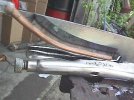- Joined
- Feb 6, 2001
- Messages
- 3,621
I am curious why such long soaks are needed for stainless steels. I work with both high carbon and 440c stainless following the recommended heat treating methods, but don't really understand why one place says soak for 5, 20 or 30 min. or why you cannot just bring the steel to critical and quench. The David Boye book on knifemaking (where I learned alot starting out, great book) says this type of hardening method is good on any steel with at least 1% carbon content. The 440c stainless I've used has a 1.2-1.5% carbon content. I've done some experiments with different hardening method including soak times (since every 5th blade or so I test to destruction I've had a few to play with) and for the most part have seen little difference in soak times quenched in warm oil. This is what happens when you learn knifemakeing from books and trial and error. Since I hate doing things without knowing why I'm doing them I was hoping for some opinions and input on what other knifemakers have experienced.
J.
www.mountainhollow.net
J.
www.mountainhollow.net

